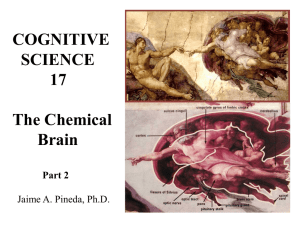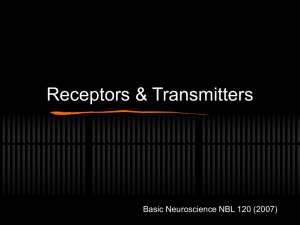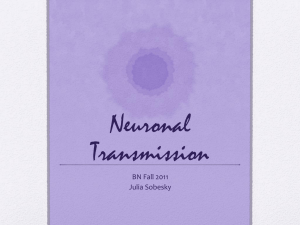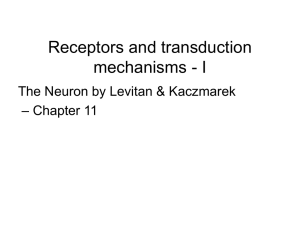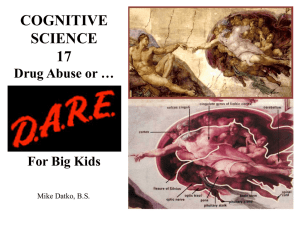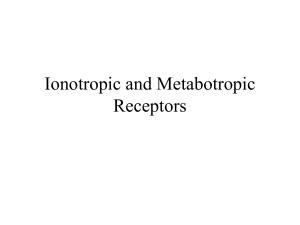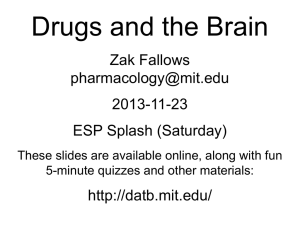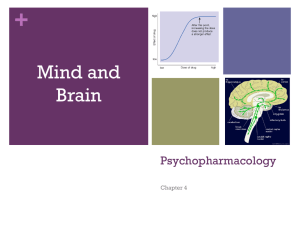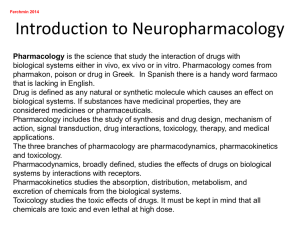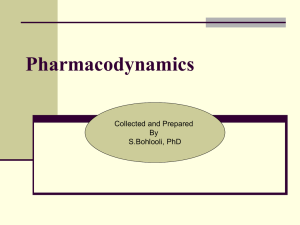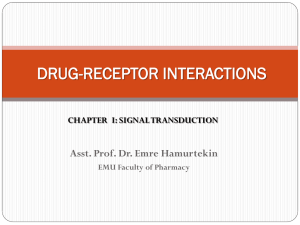NTs_2
advertisement
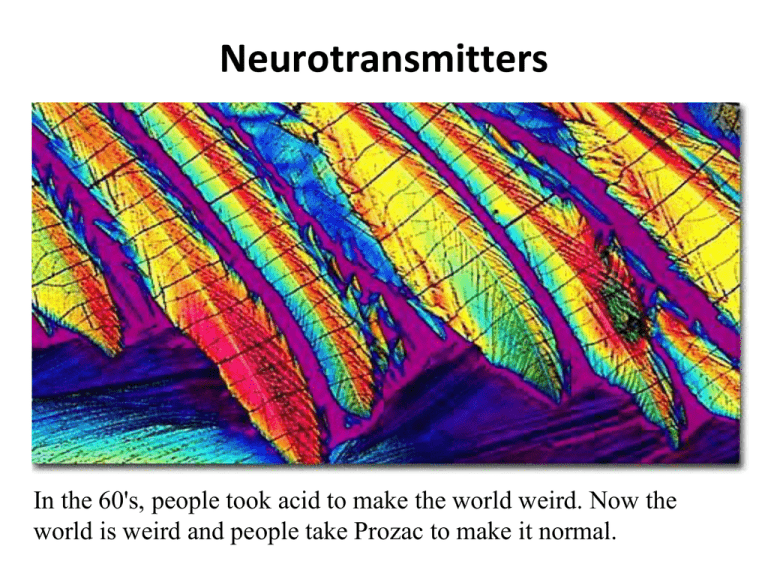
Neurotransmitters In the 60's, people took acid to make the world weird. Now the world is weird and people take Prozac to make it normal. Processes Involved in Neurotransmission • • • • • • • • • • • • Precursors (getting the raw materials) Biosynthesis (making the NTs) Storage (vesicles - Golgi bodies) Transport (neurofilaments and microtubules) Docking Influx of Ca++ Vesicle movement Exocytosis— (fusion and release) Crossing synaptic gap Binding postsynaptic receptors Reuptake mechanisms to recover NTs Deactivation Categories of NTs • Amino Acids – Glutamate (Glu) – GABA • Biogenic Amines – Quaternary Amines • Acetylcholine (Ach) – Monoamines • Catecholamines – Dopamine (DA) – Norepinephrine (NE) • Indolamines – Serotonin (5-HT) • Neuropeptides – Opioid Peptides • Enkephalins • Endorphins • Dynorphins • Others (e.g. lipids, nucleosides) Receptors • Genetically-coded proteins embedded in cell membrane • Gating – Ligand-gated – Voltage-gated • Effects - Stretch-gated ionotropic – Ionotropic – Metabotropic • Location – Postsynaptic – Presynaptic • Heteroreceptor • Autoreceptor metabotropic Ionotropic Receptors 1. Work very fast; important role in fast neurotransmission 2. 3. 4. 5. 6. Each is made of several subunits (together form the complete receptor) At center of receptors is channel or pore to allow flow of neurotransmitter At rest - receptor channels is closed When neurotransmitter bind -- channel immediately opens When ligand leaves binding site -- channel quickly closes Metabotropic Receptors 1. Work more slowly than ionotropic receptors 2. Though it takes longer for postsynapic cell to respond, response is somewhat longer-lasting Comprise a single protein subunit, winding back-and-forth through cell membrane seven times (transmembrane domains) They do not possess a channel or pore 3. 4. Theory of Drug Action Emil Fischer’s ‘Lock and Key’ Hypothesis (1890) Every ‘lock’ has its own ‘key’ If the ‘key’ is not precise, the ‘lock’ does not open The ‘drug’ is the key that has to fit the target specifically and productively Theory of Drug Action Corollary of ‘Lock & Key’ Hypothesis OH O HO O O Does not explain why some ‘keys’ open doors partially? …… e.g., partial agonists or antagonists Theory of Drug Action Daniel Koshland’s ‘Induced-Fit’ Hypothesis (1958) At least two steps …… step 1 is initial binding and step 2 is a change in structure of the receptor (and/or drug) Receptor is flexible! …… can wrap around the drug Common Neurotransmitters Involved in Dependence Probable functional dysregulation: • • • • • • Dopamine (DA) Serotonin (SER) Acetylcholine (ACh) Endorphins (END) Gamma-aminobutyric acid (GABA) Glutamate (GLU) Drugs Associated with Neurotransmitters Why do people have “drugs of choice”? • Dopamine - amphetamines, cocaine, ETOH • Serotonin - LSD, ETOH • Endorphins - opioids, ETOH • GABA - benzodiazepines, ETOH • Glutamate –ETOH • Acetylcholine - nicotine, ETOH • Anandamide – Marijuana Amino Acid NTs • High concentration in brain (micromolar) • Circuits – Cortico-cortical – Sensory-motor • Point-to-point communication • Consistently excitatory or inhibitory – Mainly ionotropic receptors but do have metabotropic receptors • Fast acting, short duration (1-5 ms) • Examples: Glutamate, Aspartate, GABA, Glycine GABA and Glutamate . • Because they are structurally very similar, various drugs affect the presence of GLU and GABA in the synaptic gap and increase or decrease action potentials. Glutamate • Principal excitatory NT • Biosynthesized as byproduct of cell metabolism • Removed by reuptake • Elevated levels neurotoxic • 4 receptor types – NMDA – AMPA Ionotropic – Kainate – mGluR - Metabotropic NMDA Binding Sites • 4 outside cell “The specific subunit composition of each receptor determines its overall pharmacological properties” – Glutamate – Glycine • Obligatory co-agonist • Inhibitory NT at its “own” receptor – Zinc (inverse agonist) – Polyamine (indirect agonist) • 2 inside cell – Magnesium (inverse agonist) – PCP (inverse agonist) GABA (Gamma Aminobutyric Acid) • Principal Inhibitory NT • Biosynthesis: Glu Glutamic Acid Decarboxylase (GAD) and B6 GABA • Removed by reuptake • 2 receptor types • GABAA GABAC (ionotropic; Cl- channel) • GABAB (metabotropic; K+ channel) GABAa Binding Sites • GABA • Benzodiazepine (indirect agonist) – Probably also site for alcohol – Endogenous inverse agonist binds here • Barbiturate (indirect agonist) • Steroid (indirect agonist) • Picrotoxin (inverse agonist) Phosphate groups attach to the receptor inside the cell and regulate receptor sensitivity (via phosphorylation) to agents such as alcohol GABAergic Drugs • Agonists (anti-anxiety) Benzodiazepines Barbiturates Ethyl alcohol (ETOH) • Antagonists • Picrotoxin • Inverse agonist Ro 15-4513 Ro15-4513, a GABAa antagonist (indirect for GABA, direct for alcohol) reverses alcohol intoxication Biogenic Amines • Medium concentration in brain (nanomolar) • Circuits – Single-source divergent projections – Mainly midbrain to cortex • Modulatory functions – Excitatory or inhibitory as a function of receptor • More metabotropic receptors than ionotropic, but plenty of both • Slow acting, long duration (10-1000 ms) • Examples: Acetylcholine, Epinephrine, Norepinephrine, Dopamine, Serotonin Acetylcholine • Mostly excitatory effects Removal Synthesis Acetyl CoA + Choline Choline Acetyltransferase (ChAT) CoA + ACh • 2 receptor types • Nicotinic (ionotropic) • Muscarinic (metabotropic) Ach Acetylcholine Esterase (AChE) Acetate + Choline Major ACh Pathways • Dorsolateral Pons mid/hindbrain [REM sleep] • Basal Forebrain cortex [Learning (esp. perceptual), Attention] • Medial Septum Hippocampus [Memory] Monoamines • Catecholamines Dopamine - DA – Dopaminergic Norepinephrine - NE – Noradrenergic Epinephrine - E – Adrenergic ~ • Indolamines Serotonin - 5-HT – Serotonergic Monoamines (DA, NE, 5-HT) • Modulatory (can have both excitatory and inhibitory effects- varies by receptor) • Recycled by reuptake transporter • Excess NT in terminal broken down by – monoamine oxidase (MAOA/B) – catechol-O-methyltranferase COMT • Axonal varicosities (bead-like swellings) with both targeted and diffuse release Dopamine • Rewarding/motivating effects • Biosynthesis: Tyrosine L-DOPA Tyrosine Hydroxylase DA DOPA Decarboxylase • Dopamine reuptake transporter (DAT) • 5 receptor types (D1–D5, all metabotropic) • D1 (postsynaptic) • D2 (pre autoreceptors and postsynaptic) • Autoreceptors are release-regulating homeostatic mechanisms Major DA Pathways • Nigrostriatral (Substantia Nigra Striatum) [Motor movement] • Mesolimbic (VTA limbic system) [Reinforcement and Addiction] • Mesocortical (VTA prefrontal cortex) [Working memory and planning] • Tuberoinfundibular tract (hypothalamus pituitary) [neuroendocrine regulation] Norepinephrine • Generally excitatory behavioral effects • Biosynthesis: DA NE Dopamine Beta-hydroxylase • Many receptor types (metabotropic) • 1, 1-2 (postsynaptic, excitatory) • 2 (autoreceptor, inhibitory) Major NE Pathway • Locus Coeruleus throughout brain [vigilance and attentiveness] Serotonin • Varying excitatory and inhibitory behavioral effects • Biosynthesis: Tryptophan 5-HTP Tryptophan Hydroxylase 5-HT 5-HT Decarboxylase • At least 14 receptor types, all metabotropic and postsynaptic except: • 5-HT1A,B,D (autoreceptors) – found in CNS • 5-HT3 (inhibitory, ionotropic) – found in the intestines Major 5-HT Pathways • Dorsal Raphe Nuclei cortex, striatum • Medial Raphe Nuclei cortex, hippocampus Roles in: Mood Eating Sleep and dreaming Arousal Pain Aggression Indirect Monoamine Agonists • MAOIs Iproniazid • Reuptake blockers – Tricyclic antidepressants • Imipramine • Desipramine - SSRIs – Cocaine & Amphetamine ~ Neuropeptides • • • • Low concentration in brain (picomolar) Large vesicles Co-localized with other transmitters Circuits – Interneuronal • • • • • Modulatory functions Mostly inhibitory Virtually all metabotropic Slow acting, long duration (10-1000 ms) Examples: Enkephalins, Endorphins, Oxytocin, Vasopressin, Opioids Opioids • -endorphin – made from proopiomelanocortin (POMC) – produced in pituitary gland, hypothalamus, brain stem • Enkephalin – made from proenkephalin (PENK) – produced throughout brain and spinal cord • Dynorphin – made from prodynorphin (PDYN) – produced throughout brain and spinal cord Opioids Receptors Receptor High affinity ligands mu delta kappa -endorphin, enkephalins enkephalins dynorphins • Opioids act at all opioid receptors, but with different affinities • Distributed throughout brain and spinal cord, especially in limbic areas • Some overlap but quite distinct localizations Opioid Receptors (cont.) • Metabotropic, with either – moderately fast indirect action on ion channels – long-term action via changes in gene expression • Most analgesic effects from mu receptor action • Some analgesic effects from delta • Many negative side effects from kappa Endorphins • Morphine and heroin are agonists that bind to receptor sites, thereby increasing endorphin activity An Evolutionary Perspective Nesse and Berridge, 1997 “The problem is rooted in the fundamental design of the human nervous system” • An electrochemical brain – Neurotransmitters have retained function for millions of years and are found in many species - from invertebrates to humans • Maximization of Darwinian fitness – Evolution created many chemically-mediated adaptive and self-regulatory mechanisms to control emotion and behavior • Mismatch between ancient chemical mechanisms and modern environments Darwinian Fitness – DA and opioids are part of chemically-mediated incentive mechanisms that act as signals (motivation/reward) for a fitness benefit • you “like” something (opioids) or • you “want” something (dopamine) – Furthermore, DA plays a role in drawing attention/highlighting significant or surprising stimuli • Mechanisms for greater control? As a means to prioritize likes? for anticipatory processing? facilitates learning? – These functions become susceptible to disruption and addiction from external chemical signals Mismatch – Technological inventions such as the hypodermic needle, synthetic psychoactive drugs, video games, snacks etc are evolutionarily novel features that create specific ecological pressures • They can be inherently pathogenic because they bypass the adaptive mechanisms and act directly on neurotransmitter systems – positive emotions are signals to approach » drugs that artificially induce positive emotions give a false signal of a fitness benefit » under some circumstances this could be beneficial (increase empathy) – negative emotions are signals to avoid » drugs that block negative emotions can impair useful defenses » is there utility to anxiety? jealousy? low mood and depression (decrease the tendency for behaviors that are dangerous or useless? embarrassment and guilt (regulating the individual’s hierarchical role in a group? Drug Effects • External drugs hijack these evolved incentive mechanisms and most likely impair adaptation – When exposed to drugs the wanting system motivates persistent pursuit of drugs that no longer give pleasure – a core feature of addiction. – Drugs produce sensitization of incentive mechanisms
